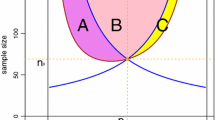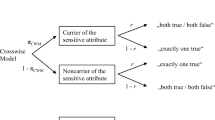Abstract
The Klein design is a response-driven random rule to allocate experimental subjects between two treatments. It aims to allocate more subjects to the treatment that is performing better, and therefore it is useful when ethical issues are of prime interest. It behaves asymptotically as the drop-the-loser rule, which is known to have a high degree of compromise between ethics and inferential properties. Besides, the Klein design has a powerful stochastic structure, which permits to obtain exact values, for each sample size n, for its main operating characteristics, such as variability of allocations, expected failure rate and power, selection bias or accidental bias. These properties of the Klein design are thoroughly studied and we obtain exact and asymptotic results.
Similar content being viewed by others
References
Baldi Antognini A, Giannerini S (2007) Generalized Pólya urn designs with null balance. J Appl Probab 44:661–669
Bélisle C, Melfi V (2007) Independence after adaptive allocation. Stat Probab Lett 78(3):214–224
Chen Y (2000) Which design is better? Ehrenfest urn versus biased coin. Adv Appl Probab 32:738–749
Chen Y (2006) A central limit property under a modified Ehrenfest urn design. J Appl Probab 43:409–420
Dasgupta A (2008) Asymptotic theory of statistics and probability. Springer, New York
Efron B (1971) Forcing a sequential experiment to be balanced. Biometrika 58(3):403–417
Flournoy N, Haines LM, Rosenberger WF (2013) A graphical comparison of response-adaptive randomization procedures. Statistics in Biopharmaceutical Research. doi:10.1080/19466315.2013.782822
Hu F, Rosenberger WF (2003) Optimality, variability, power: evaluating response-adaptive randomization procedures for treatment comparisons. J Am Stat Assoc 98(463):671–678
Hu F, Rosenberger WF (2006) The theory of response-adaptive randomization in clinical trials. Wiley, New York
Hu F, Zhang L (2004) Asymptotic properties of doubly adaptive biased coin designs for multitreatment clinical trials. Ann Stat 32(1):268–301
Ivanova A (2003) A play-the-winner-type urn design with reduced variability. Metrika 58:1–13
Katti SK (1960) Moments of the absolute difference and absolute deviation of discrete distributions. Ann Math Stat 31(1):78–85
Klein MJ (1956) Generalization of the Ehrenfest urn model. Phys Rev 103(1):17–20
Knopp K (1990) Theory and applications of infinite series. Dover Publications Inc, New York
Mahmoud HM (2008) Pólya urn models. Chapman & Hall/CRC, Boca Raton
Markaryan T, Rosenberger WF (2010) Exact properties of Efron’s biased coin randomization procedure. Ann Stat 38(3):1546–1567
Rosenberger WF, Hu F (2004) Maximizing power and minimizing treatment failures in clinical trials. Clin Trials 1:141–147
Rosenberger WF, Lachin JM (2002) Randomization in clinical trials. Theory and practice. Wiley, New York
Smith RL (1984) Treatment allocation using biased coin designs. J R Stat Soc Ser B 46(3):519–543
Tong Z, Mahmoud HM (2012) An Urn model for population mixing and the phases within. Methodol Comput Appl Probab. doi:10.1007/s11009-012-9275-x
Author information
Authors and Affiliations
Corresponding author
Additional information
Partially supported by the projects MTM2010-15972 and MTM2012-36025.
Rights and permissions
About this article
Cite this article
Galbete, A., Moler, J.A. & Plo, F. A Response-Driven Adaptive Design Based on the Klein Urn. Methodol Comput Appl Probab 16, 731–746 (2014). https://doi.org/10.1007/s11009-013-9344-9
Received:
Revised:
Accepted:
Published:
Issue Date:
DOI: https://doi.org/10.1007/s11009-013-9344-9




